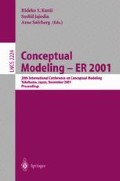Abstract
XML is a common standard for semi-structured and structured data representation and exchange over the Web. This paper describes a semi-automatic process for converting an XML DTD to a schema in a canonical conceptual model based on ORM/NIAM and extended ER models. This process is part of a bottom-up approach for integration of XML sources that takes a set of DTDs and generates an ontology for query purposes. Ac onceptual schema for a DTD simplifies the integration activity because provides a semantically rich representation of an XML source. The core of the process is a set of conversion rules that consider the DTD structure and heuristics related to default semantic interpretations on such structure in order to generate the corresponding concepts in the canonical conceptual schema.
This work is partially supported by CAPES Foundation.
Access this chapter
Tax calculation will be finalised at checkout
Purchases are for personal use only
Preview
Unable to display preview. Download preview PDF.
References
C. Batini, S. Ceri, and S. B. Navathe. Conceptual Database Design: An Entity-Relationship Approach. Benjamin/Cummings Publishing Company, 1992.
R. Behrens. A grammar based model for xml schema integration. In XVII British National Conference on Databases (BCNOD), 2000.
L. Bird, A. Goodchild, and T. Halpin. Object role modeling and xml-schema. In 19th International Conference on Conceptual Modeling (ER’2000), pages 309–322, October 2000.
S. Castano, V. Antonellis, and S. C. Vimercati. An xml-based framework for information integration over the web. In International Workshop on Information and Web-Based Application and Services (IIWAS 2000), Yogyakarta, Indonesia, September 2000.
R. Conrad, D. Scheffner, and J. C. Freytag. Xml conceptual modeling using uml. In 19th International Conference on Conceptual Modeling (ER’2000), pages 558–571, October 2000.
D. Fensel, I. Horrocks, F. V. Harmelen, S. Decker, M. Erdmann, and M. Klein. Oil in a nutshell. In 12th European Workshop on Knowledge Acquisition, Modeling, and Management (EKAW’00), 2000.
T. Halphin. Object-Role Modeling (ORM/NIAM), Handbook on Architectures of Information Systems, chapter 4. Spring-Verlag Berlin/Heidelberg, 1998.
M. Liu and T. W. Ling. Acon ceptual model for the web. In 19th International Conference on Conceptual Modeling (ER’2000), pages 225–238, October 2000.
B. Ludäscher, Y. Papakonstantinou, P. Velikhov, and V. Vianu. View definition and dtd inference for xml. In ICDT Workshop on Query Processing for Semistructured Data and Non-standard Data Formats, 1999.
P. McBrien and A. Poulovassilis. A semantic approach to integrating xml and structured data sources. In 13th Conference on Advanced Information Systems Engineering (to appear), June 2001.
R. S. Mello. An Integration Layer for Semantic Unification of XML sources. PhD thesis, Informatics Institute — Federal University of Rio Grande do Sul, 2001.
R. S. Mello and C. A. Heuser. A bottom-up approach for integration of xml sources. In International Workshop on Information Integration on the Web, apr 2001.
Y. Papakonstantinou, H. Garcia-Molina, and J. Widow. Object exchange across heterogeneous information. In International Conference on Data Engineering, pages 251–260, 1995.
W3C Resource Description Framework RDF. Available at: http://www.w3.org/RDF/ .
S. Cluet, C. Delobel, J. Siméon, and K. Smaga. Your mediators need data conversion! In SIGMOD Conference, pages 177–188, June 1998.
R. Vdovjak and Geert-Jan Houben. Rdf-based architecture for semantic integration of heterogeneous information sources. In International Workshop on Information Integration on the Web, apr 2001.
W3C Extensible Markup Language XML. Available at: http://www.w3.org/XML .
W3 XML-Schema. Available at: http://www.w3.org/XML/Schema .
Author information
Authors and Affiliations
Editor information
Editors and Affiliations
Rights and permissions
Copyright information
© 2001 Springer-Verlag Berlin Heidelberg
About this paper
Cite this paper
Mello, R.d.S., Heuser, C.A. (2001). A Rule-Based Conversion of a DTD to a Conceptual Schema. In: S.Kunii, H., Jajodia, S., Sølvberg, A. (eds) Conceptual Modeling — ER 2001. ER 2001. Lecture Notes in Computer Science, vol 2224. Springer, Berlin, Heidelberg. https://doi.org/10.1007/3-540-45581-7_12
Download citation
DOI: https://doi.org/10.1007/3-540-45581-7_12
Published:
Publisher Name: Springer, Berlin, Heidelberg
Print ISBN: 978-3-540-42866-4
Online ISBN: 978-3-540-45581-3
eBook Packages: Springer Book Archive

